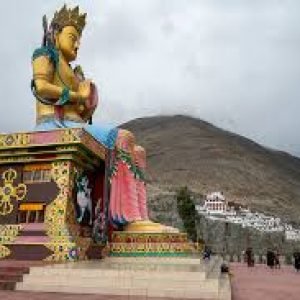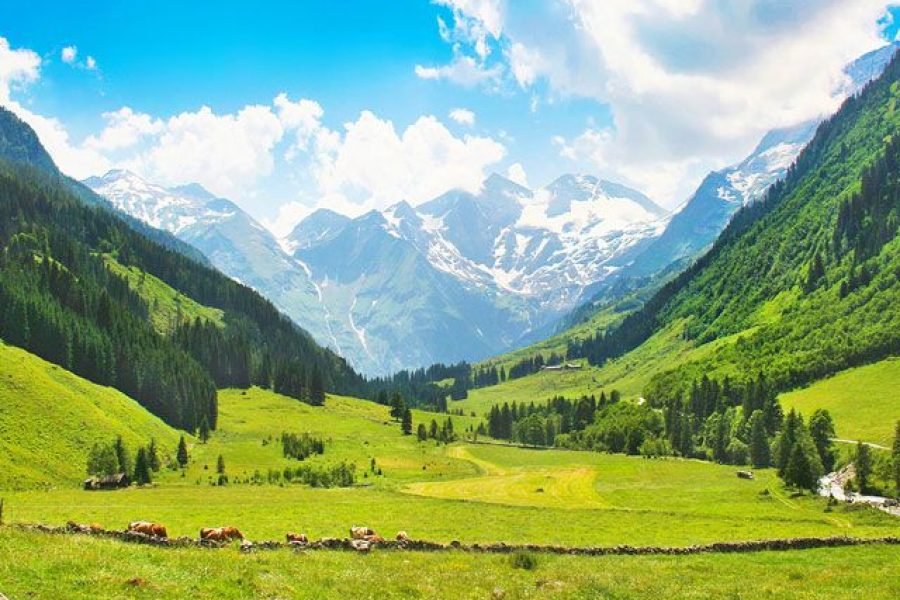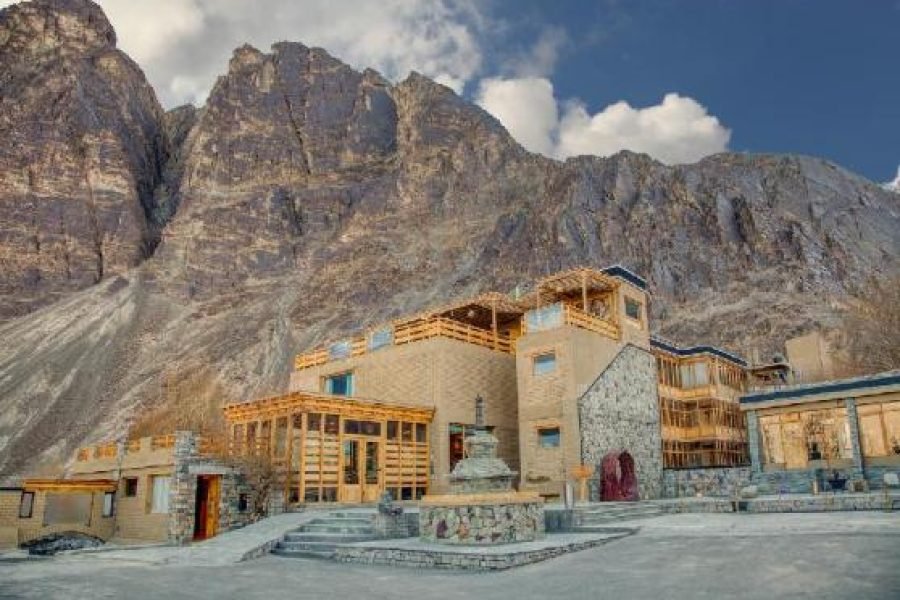Diskit Gompa : A Sacred Sanctuary Overlooking Nubra Valley





Table of Contents
ToggleDiskit Gompa lies within the rugged beauty of Ladakh, a world-famous Tibetan Buddhist monastery based in the Nubra Valley. It is known to be a place of spiritual significance and majestic views. Diskit Gompa is not just a shrine but also an epitome of the rich cultural heritage in Ladakh. This post will take you through a journey of the history of Diskit Gompa, its architecture, and its significance as well as the landscape surrounding it. Whether you’re a spiritual seeker, a history enthusiast, or an adventure traveler, this detailed guide will help you explore one of Ladakh’s most iconic landmarks.
The History of Diskit Gompa
It is well established that Diskit Gompa was founded during the 14th century, and it remains among the oldest and most historically significant monasteries in the region. The monastery is of the Gelugpa sect of Tibetan Buddhism, which was actually founded by Tsongkhapa during the 14th century. Its construction is attributed to Changzem Tserab Zangpo, a disciple of the great Tibetan scholar and spiritual leader, Tsongkhapa.
Diskit Gompa stands the test of time, reflecting Buddhism and its core teaching throughout its centuries-long existence with the resident monks living by its teachings and values. It is also one of the most important centers of education of Buddhism. These are conducted through a lot of learning processes among monks and lamas about scriptures, meditation, and Tibetan culture. It is one sacred place of serenity that evokes spiritual energy; people travel from every corner of the globe to come and behold.
Location and How to Reach Diskit Gompa
Diskit Gompa is located in Nubra Valley, which is a remote region in the northernmost part of India. To reach Diskit, tourists must first reach Leh, the capital of Ladakh, which is connected by road and air to major Indian cities like Delhi, Jammu, and Srinagar. From Leh, it is approximately 6 to 7 hours to Diskit by road through Khardung La Pass, which claims to be one of the highest motorable roads at 5,359 meters (17,582 feet) in the world.
The journey from Leh to Diskit offers a once-in-a-lifetime opportunity to witness the stunning Ladakhi landscape, with its vast desert-like terrain, towering mountains, and lush greenery along the Nubra River. The journey also takes travelers through the famous Khardung La Pass, offering spectacular panoramic views of the surrounding Himalayan peaks and valleys.
The Spiritual Significance of Diskit Gompa
Diskit Gompa is not only an architectural marvel but it also has significant spiritual values. As a Buddhist monastery, it provides a place for meditation, prayer, and contemplation. Within the monastic complex are numerous statues of Buddha that include the 32-meter (105-foot) high Maitreya Buddha, standing on the hilltop above the monastery in the direction of the Shyok River.
The Maitreya Buddha statue is one of the major attractions and icons found in Diskit Gompa. It symbolizes the future Buddha, who will bring peace and happiness to the world. This means that the Maitreya statue in Diskit Gompa reinforces the spiritual significance of the monastery by being a hope, love, and compassion manifest. The visitors to the monastery often spend time in prayer and meditation, finding solace in the serene environment and spiritual energy that permeates the surroundings.
Architecture of Diskit Gompa
Diskit Gompa is an excellent example of Tibetan Buddhism architecture, blending Ladakhi and Tibetan traditional style. The monastery sits atop a rocky hill, commanding great views of the Nubra Valley below. This multi-storied monastery complex has several prayer halls, living spaces for the monks, and many shrines for the various Buddhist gods.
The Gompa is painted with colorful murals, intricate carvings, and thangkas, traditional Tibetan Buddhist paintings. The works of art include scenes from the life of Lord Buddha and other deities of Buddhism and teachings. Prayer halls in the monastery reverberate with the chanting monks and the fragrance of incense fills the air, evoking deep spirituality and peace.
The prayer wheel is one of the most important architectural features of the Diskit Gompa: it is quite large in size and in the form of a great cylindrical wheel that devotees traditionally spin while walking around the monastery. It is believed that spinning the wheel brings blessings, purifies negative karma, and generates positive energy.
The Maitreya Buddha Statue: A Symbol of Peace
The Maitreya Buddha statue stands above Diskit Gompa, without a doubt, one of the most breathtakingly beautiful views in Ladakh. Standing 32 meters (105 feet) tall, the statue can be seen from miles away, and its presence is a symbol of hope and peace to all those who visit it. Constructed in 2010, the Maitreya Buddha statue was erected as a form of respect to Buddha’s teachings and for the promotion of peace in the region.
This statue is an incredible piece of engineering and art. It is made of copper, covered with gold. Maitreya Buddha has very fine details and intricate design with each small thing created to symbolize the concept of Buddhist teachings. This statue has been positioned strategically at a place on the hill overlooking the entire Nubra Valley from the top of the monastery.
Visitors to Diskit Gompa often take a pilgrimage to the Maitreya Buddha statue, offering prayers and seeking blessings for peace and well-being. The view from the statue is truly breathtaking, as it offers a panoramic vista of the surrounding valley, with its golden sand dunes, flowing rivers, and snow-capped mountains in the distance.
Festivals and Celebrations at Diskit Gompa
Diskit Gompa holds great significance as an important center for religious festivals and cultural celebrations. One of the most attended festivals here is the Ladakh Festival, which usually falls in September. The monastery becomes a colorful affair, thronged with colorful prayer flags and traditional decorations, as monks perform elaborate rituals, dances, and prayers.
The other prominent festival is Dosmochey Festival, celebrating the victory of good over evil. As part of this festival, monastic robes are donned by the monks with masks and costumes as they chant sacred dances for wholesome blessings toward the community’s well-being and to ward off evil.
Similarly, the Tibetan New Year or Losar is celebrated with fervor here at Diskit Gompa, as it is filled with music, dance, and prayers by the locals in ushering in a new year of prosperity and happiness. The festivals afford a unique opportunity for visitors to enjoy the vibrant culture and spirituality of Ladakh.
Treks and Adventure Activities Near Diskit Gompa
While Diskit Gompa is primarily known for its spiritual and cultural significance, the surrounding Nubra Valley is also a popular destination for adventure enthusiasts. The valley is a hub for trekking, camping, and jeep safaris, offering a unique chance to explore the rugged terrain and stunning landscapes of the region.
One of the most popular trekking routes near Diskit is Nubra Valley Trek that takes you to some of the valley’s most picturesque villages, remote monasteries, and desert landscapes at high altitude. The trek offers an unforgettable experience, with stunning views of the Karakoram Range, the Shyok River, and the sand dunes of Hunder.
Another popular activity in the area is the Bactrian Camel Ride through the Hunder Sand Dunes. The unique two-humped camels, also called the “ships of the desert,” are a major attraction in Nubra Valley. Riding the camels across the golden sands gives visitors an opportunity to experience the region’s desert-like landscape in an unforgettable way.
The Nubra Valley is also famous for its natural beauty, pristine rivers, lush green valleys, and dramatic mountain ranges. Be it adventure or peace and tranquility, the Nubra Valley and Diskit Gompa have something for everyone.
Best Time to Visit Diskit Gompa
The best time to visit Diskit Gompa is during the summer months, May to September, when the weather in Ladakh is more pleasant, and the region is easily accessible. During this time, temperatures are well-balanced for undertaking massive outdoor tours, such as trekking and camel rides.
The winter season, from November to February, is quite freezing. While snow-capped landscapes during the winter season can be scenic, the situation can be pretty challenging for people traveling for the first time during such cold weather and high-altitude conditions.
Visitors interested in witnessing the vibrant festival and cultural events at Diskit Gompa should plan their visit around the time of the Ladakh Festival or the Dosmochey Festival.
Conclusion: A Spiritual and Scenic Journey
Diskit Gompa is a timeless testimony to the rich spiritual, cultural, and architectural legacy of Ladakh. Whether you are attracted by the serene and peaceful ambiance that surrounds the place, its beauty in design, or even the awesome landscapes that flank it Diskit Gompa is simply an experience that lingers much after you leave.
The monastery allows one to connect with the teachings of Buddhism and have time for reflection in an extremely serene and peaceful environment. For the adventurous and nature lover, Nubra Valley is endless and open to discovery. Diskit Gompa is quintessentially Ladakh: deeply spiritual, rich in history, and incredibly beautiful in nature.
So, whether you are a traveler who wants peace, an adventure fan, or a history lover, Diskit Gompa is sure to be a memorable and enriching experience.
FAQ's
1. What is Diskit Gompa?
Diskit Gompa, also known as Diskit Monastery, is a Tibetan Buddhist monastery located in Nubra Valley, Ladakh. It is one of the oldest and largest monasteries in the region, known for its spiritual significance and breathtaking views. The monastery houses several statues of Buddha, including the 32-meter tall Maitreya Buddha statue.
2. Where is Diskit Gompa located?
Diskit Gompa is located in the Nubra Valley of Ladakh, India. The monastery is situated at an altitude of around 3,150 meters (10,300 feet) above sea level, near the town of Diskit, which is about 150 km from Leh, the capital of Ladakh.
3. How do I reach Diskit Gompa from Leh?
To reach Diskit Gompa, you must first travel to Leh, which is well-connected by road and air to major cities in India. From Leh, you can drive to Diskit Gompa via the Khardung La Pass, a journey that takes around 6-7 hours. The road provides stunning views of the surrounding mountains and valleys.
4. What is the significance of the Maitreya Buddha statue at Diskit Gompa?
The Maitreya Buddha statue at Diskit Gompa stands at 32 meters (105 feet) and symbolizes the future Buddha, who is believed to bring peace, happiness, and prosperity to the world. The statue is one of the largest of its kind in the region and is a prominent feature of the monastery.
5. What is the history of Diskit Gompa?
Diskit Gompa was established in the 14th century by Changzem Tserab Zangpo, a disciple of the renowned Tibetan scholar Tsongkhapa. It belongs to the Gelugpa school of Tibetan Buddhism and has been an important center for religious teachings and Buddhist studies in Ladakh for centuries.
6. What are the best times to visit Diskit Gompa?
The best time to visit Diskit Gompa is from May to September when the weather in Ladakh is pleasant and accessible for travel. The temperatures are moderate, making it ideal for outdoor activities. The winter months (November to February) are extremely cold and may make travel challenging.
7. Can I visit Diskit Gompa during festivals?
Yes, visiting Diskit Gompa during festivals like the Ladakh Festival, Dosmochey Festival, or Losar (Tibetan New Year) offers a unique experience. The monastery is adorned with colorful decorations, and you can witness traditional dances, rituals, and prayers performed by the monks.
8. What activities can I do around Diskit Gompa?
Around Diskit Gompa, you can enjoy trekking, camel rides, and exploring the Nubra Valley. The valley is known for its dramatic landscapes, including the Hunder Sand Dunes, and offers opportunities for jeep safaris and trekking routes like the Nubra Valley Trek.
9. How long does it take to visit Diskit Gompa?
A visit to Diskit Gompa typically takes a few hours, depending on how much time you wish to spend exploring the monastery, the Maitreya Buddha statue, and the surrounding area. If you’re traveling to Nubra Valley for a longer stay, you can also explore nearby attractions like the Hunder Sand Dunes.
10. What is the architecture of Diskit Gompa like?
Diskit Gompa features traditional Tibetan Buddhist architecture, with multi-storied buildings, prayer halls, intricate murals, and colorful thangkas (paintings). The monastery is built on a rocky hilltop, offering stunning views of Nubra Valley and is adorned with prayer wheels that devotees spin for blessings.
11. Is there accommodation near Diskit Gompa?
Yes, there are several guesthouses, hotels, and homestays near Diskit Gompa. The nearby town of Diskit offers basic accommodations, and there are also options for camping in Nubra Valley for those looking for a more rustic experience.
12. Is it safe to travel to Diskit Gompa and Nubra Valley?
Yes, it is generally safe to travel to Diskit Gompa and Nubra Valley. However, due to its high altitude, it’s important to acclimatize in Leh before heading to Nubra Valley to avoid altitude sickness. Always check road conditions during winter, as certain areas may be inaccessible due to snow.
13. Can I take photographs at Diskit Gompa?
Yes, photography is allowed at Diskit Gompa, but you should be respectful of the religious space. It’s recommended to ask for permission before taking photos, especially inside the prayer halls and near the monks. Photography of the Maitreya Buddha statue is also a popular activity.
14. What are the major attractions near Diskit Gompa?
Major attractions near Diskit Gompa include the Hunder Sand Dunes, where you can take a Bactrian camel ride; the Sumur Monastery, another important Buddhist site in Nubra Valley; and Panamik Hot Springs, which is known for its therapeutic properties.
15. What is the cultural importance of Diskit Gompa?
Diskit Gompa is not only a place of spiritual significance but also a cultural hub for Tibetan Buddhism. It preserves and promotes Buddhist traditions, art, and culture in the region. The monastery is an important center for education, meditation, and cultural celebrations, attracting both pilgrims and tourists interested in Ladakhi heritage.
How to book Tours for Ladakh with Charzan Holidays?
For a seamless and exceptional booking experience, contact Charzan Holidays at reservations@charzan.in or call us at +919622224473









0 Comment